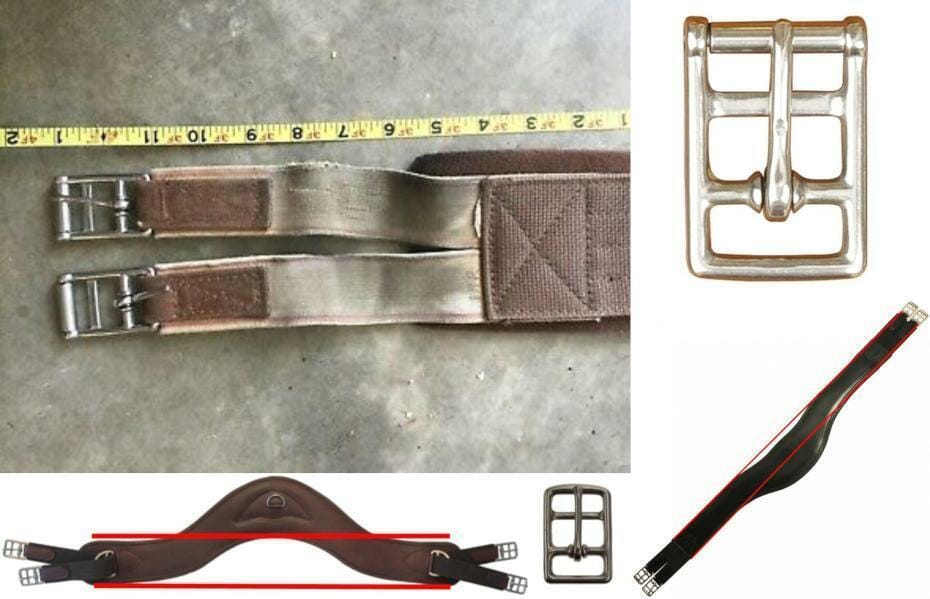 BY GEORGIE WELGE, SMS QSF, MSFCdip, EE – EQUITOPIA’S SADDLE FITTER FROM THE UK. GEORGIE IS ONE OF THE FOUNDERS OF MASTER SADDLE FITTERS INTERNATIONAL (MSFI) AND HAS WORKED AS A SADDLE FITTER FOR MORE THAN 12 YEARS.
BY GEORGIE WELGE, SMS QSF, MSFCdip, EE – EQUITOPIA’S SADDLE FITTER FROM THE UK. GEORGIE IS ONE OF THE FOUNDERS OF MASTER SADDLE FITTERS INTERNATIONAL (MSFI) AND HAS WORKED AS A SADDLE FITTER FOR MORE THAN 12 YEARS.
Every rider uses one! How many of you actually give them much consideration? In recent years more research has been carried out on girths to show they can have a large impact on the wellbeing and movement of your horse. In 2013, a study on the girth revealed that the pressure points of the girth were located on the caudal (rear) side of the elbow and across the sternum. As the elbow comes back over the girth during movement, the pressure is increased.
The curved girth has been a popular design for many years now. They come in different shapes and under different names. Let’s try to look at the differences between some of them. I have heard of the girths in question being called C girths, curved girths, anatomical ergonomic shoulder relief girths and so on, but what is the difference? To be honest, the answer is – not a lot. The fancy sounding names are basically words companies use to market their product, trying to make it stand out from the others! A good term for these types of girths is anatomical girths, as the design of the girth takes the horse’s anatomy and well-being into account.
It is important to keep in mind that not all girths, sold as “anatomical” are actually that. The difference in some of the girths is quite staggering. For instance in Photo 1 below, I have a girth that has been sold as an anatomical girth. Notice how the buckles and the centre section are not really out of alignment just cleverly shaped a little to give the optical illusion of an offset centre section. This is common in cheaper “anatomical” girths as it saves material.
Conversely in Photo 2 below, we can see that the whole girth is curved with the centre of it being completely offset to the buckle ends. In this girth, even the upright of the girth leading to the buckle ends are tilted to give even more curve and angle to the whole thing. This is a true anatomical girth, as its shape actually is made to be more comfortable for the horse.

BUCKLES
How many of you take the actual buckle into account when selecting a girth? For the sake of the longevity of your girth straps and the ease of doing up, try and choose a roller buckle on both ends. Roller buckles ease the strain placed on the strap when doing them up and can lessen the stretching that occurs on the girth straps/billets. They can also make it a lot easier to do them up.  ELASTIC
ELASTIC
As horse riders, we aim for symmetry and balance wherever possible. So why would we put an asymmetric girth on? The girth with the elastic on one end was designed a long time ago as a way of making girthing up easier. Since then we have realized there are some issues with this design, yet people are still purchasing them. The elastic being on only one end effectively creates an asymmetrical effect on the horse. The end with the elastic is going to be moving more, thus being more dynamic and the other end will be more stable. This can add to the effect of the saddle slipping in some rounder shaped horses and ponies. That said, the girth with the elastic on one side can actually aid in the stability of slipping saddle if used the correct way. For instance, if the saddle is slipping to the left we can place the elastic end on the left and the non-elastic end on the right to offer more stability to that side. The length of the elastic is also relevant. The longer the elastic, the less stability the girth will offer. The quality of the elastic and the ply will also affect the stability.
The condition of the elastic is of utter importance also, as the properties of the material will change with long term usage. If your girth has frayed elastic, replace it as soon as possible. Once elastic starts getting to this state it will not take much for it to break completely. Another thing to check regularly is the general state of the girth, including the stitching. Synthetic girths tend to get brittle with age and they can crack and split which can cause pinching of the skin.

CHECKING YOUR GIRTH
Now going back to that study in 2013, the study itself was aimed at elbow release. I think an interesting subject that did not get talked about is that of the pressure across the sternum. In the images from the paper, it is clear to see higher pressure across the sternum and less on the sides of the rib cage. This is important to note as this region is where everyone tests the tension on the girth. Something that you should keep in mind is that the pressure and force exerted on the sternum of the horse by the girth is quite large. Due to this, care should be taken not to over-tighten the girth. When checking your girth, place your hands down the girth and feel in the area of the sternum rather than at the sides of the girth! Because of the shape of the horse’s ribcage, the sides of the girth will feel looser than the pressure being applied to the sternum underneath.
IF YOU FOUND THIS POST INTERESTING, YOU MIGHT BE INTERESTED TO SEE MORE ON THIS TOPIC:
https://www.equitopiacenter.com/shop/the-essential-guide-to-saddle-fitting/
https://www.equitopiacenter.com/videos/what-to-expect-in-a-saddle-fit-evaluation/
For more resources, check out the Equitopia membership program – click here




